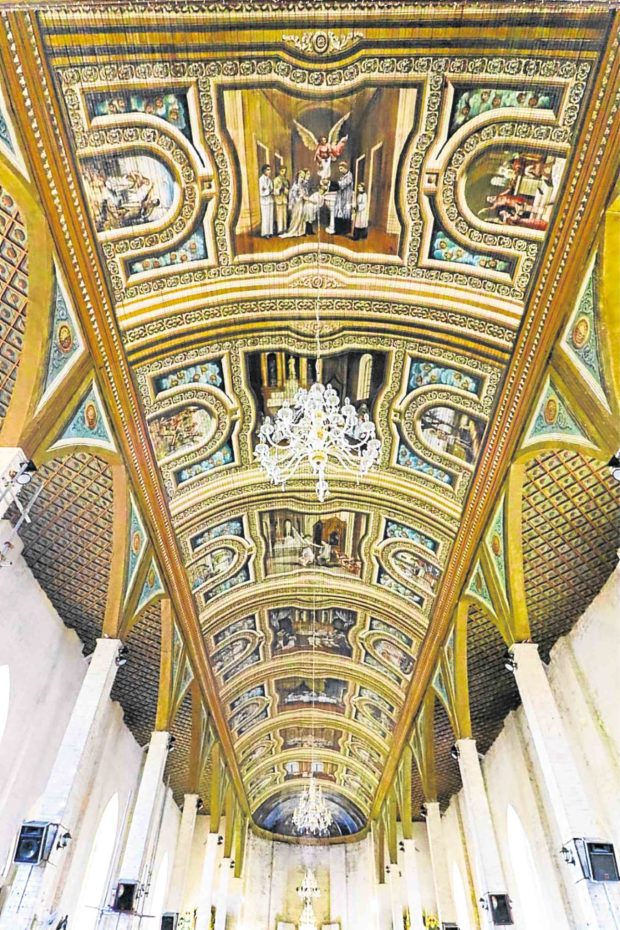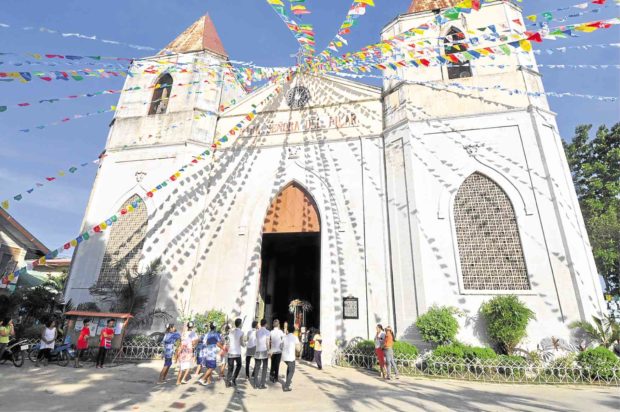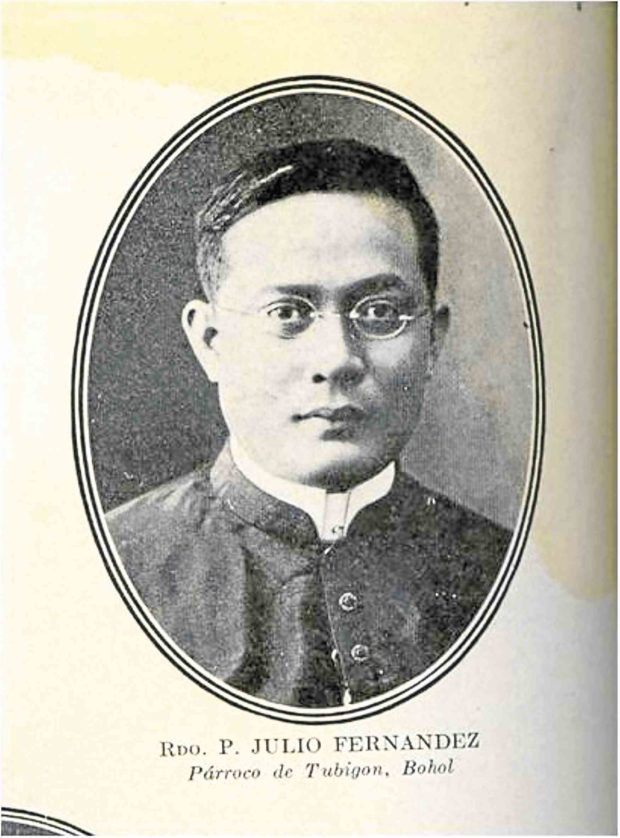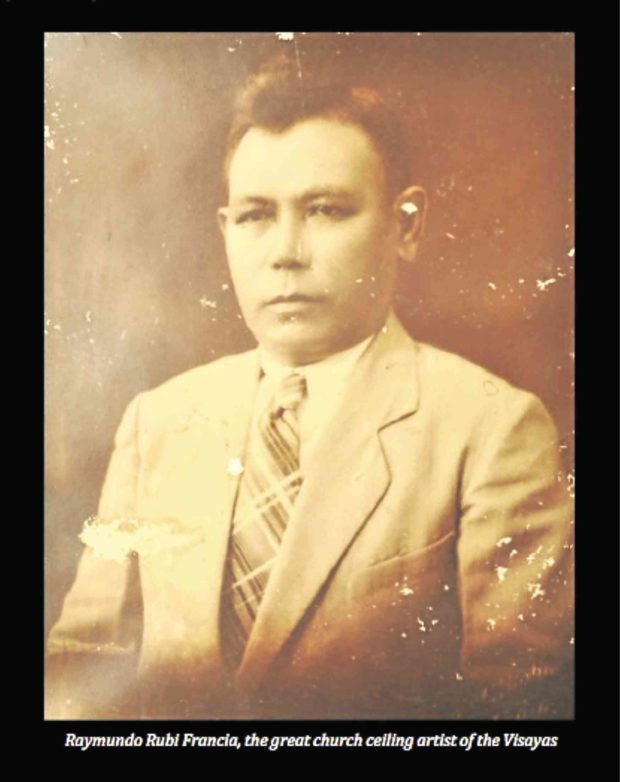Ceiling art astounds churchgoers

TEACHING RELIGION The mural on the ceiling of Virgin of the Pillar Parish church in Sibonga, Cebu, has become an important teaching aid for catechists during religion classes in summer. JASON MATTHEW LIM / CONTRIBUTOR
SIBONGA, Cebu — From the outside, the small church in this town in the southeastern part of Cebu province looks unassuming. Modesty, however, steps aside inside Virgin of the Pillar Parish, where a stunning religious-themed painting stretches on the ceiling from the choir’s loft to the altar.
Considered a landmark in the third-class municipality of 48,186 people, the overhead art piece has become an outstanding tribute to local heritage and culture, though it has risen from a simple repair job by an artistically inclined parish priest in 1924.
The parish is the only one in the Archdiocese of Cebu that showcases an extensive artist’s legacy.
Julio Fernandez was just five months serving as “cura parroco” (parish priest) of Virgin of the Pillar Parish when he was told by the bishop that he would be hosting people on a diocesan visit to the church.
The visitors, who acted as eyes and ears of the bishop, were inspecting every member parish.
Article continues after this advertisementWhen they went to the church in Sibonga, they saw its dilapidated ceiling — a discordant note to its proud and slender structure and the local people’s deep faith.
Article continues after this advertisementThey authorized Fernandez to raise funds for the repair but cautioned him to use the money reasonably.
More than repair work
Fernandez did more than that. He commissioned Raymundo Francia, a Cebuano renowned for his mural paintings in other churches in the province and its neighbor, Bohol, to execute another masterpiece in Sibonga.
The ceiling material of woven thin bamboo slats was stripped and replaced with hundreds of board feet of timber that would serve as canvas for the mural.
Francia started painting “Seven Days of Creation” above the altar and moved toward the nave, dividing it into seven sections to depict the seven sacraments.
A huge depiction of Christ’s Crucifixion occupies the area over the choir loft. On the tail end of the nave, the artist’s signature appears.
According to Raymund Fernandez of the University of the Philippines (UP) Cebu’s Fine Arts Department, the inscription of Francia’s signature shows 1927, which may indicate the year it was made.
But it can be deduced from documents that the ceiling art was made from 1927 to 1931.
The documents also showed that Francia was paid in 1931 for all his works that included the ceiling piece, paintings of four evangelists on the altar wall and the decorative accents on the interior walls.
Melchor Llanos was barely a teenager when he watched the artist working on the mural.
Now 98, Llanos recalled that segments of the painting, especially the head part, were painted on pieces of tin that were fitted against the ceiling like a giant jigsaw puzzle.
In a 2006 interview, Leopoldo Hermosisima said he also saw Francia painting in a reclined position while suspended in midair.
European influence
Artist Walter Vestil of nearby Carcar City said that based on the elements of composition, only one artist was behind the whole mural.
Francia, he noted, had a strong European influence, particularly from the Dutch master Rembrandt and the Spanish master Diego Velazquez during the Baroque period.
Francia’s original technique is called “wet-on-wet,” in which layers of wet paint are applied to previously applied layers of wet paint without waiting for them to dry, Vestil said.
This way, the artist worked faster and sooner than the usual, he added.
While the human figures are carefully scaled, estimating proportions of body parts may have challenged him, Vestil said.

CULTURAL TREASURE The modest Virgin of the Pillar Parish church is a cultural treasure of Sibonga. —NOEL PONCE
He corroborated claims that certain cephalic sections were painted on tin media. Francia, he said, might have been more comfortable doing these pieces on the ground than on the ceiling.
Mix of colorants
But Vestil said Francia’s greatest strength was his way of mixing the colorants. With a penchant for a red undertone, the artist played excellently with lightness and darkness to render an especially soothing balance of color on all his pieces of realism.
In today’s digital age, it is easier to compose an array of colors. Back then, however, it demanded immeasurable time and discipline to come up with these characteristic hues.
Vestil is amazed at the borders of each panel. These bear ornate designs that just seem to have been applied redundantly on wood.
Gazing from the ground, the designs appear to have been carved, creating an illusion of depth on flat surface.
This is the basis for the inclusion of the French phrase “trompe-l’oeil” (to deceive the eye) in the inscription of Sibonga church’s historical marker.
Over time, the mural was damaged, mainly due to changes in temperature and humidity, pollution, water seepage and even infestation.
In 2016, a team of experts and enthusiasts initiated a restoration project.
In his paper, “A Preliminary Study of Ceiling Murals from Five Southeastern Cebu Churches in 2013,” Cebuano professor Reuben Cañete of UP Diliman noted that the paintings were endangered by numerous small cavities in the nave where water seepage from the roof had penetrated to the paint layer.
The joints of the timbers also showed numerous water intrusions that were slowly dissolving the mural, Cañete reported.
“Despite extensive water damage, the general presence of surface mold, and the smell of wood rot and bat droppings, the murals are in a remarkable state of visual preservation,” he said.
Restoration work
In 2016, a team of experts and enthusiasts led by Joel Aldor initiated a restoration project.
The National Commission for Culture and the Arts has supported the group’s conservation works on the artistry of the Spanish colonial churches in the country.
Proper conservation techniques were apparently followed by the team. With the artwork’s preservation, its historico-aesthetic relevance is now underscored.
Today, the mural makes for a good teaching material. Catechists use it as reference during religion classes in summer.
The depiction of the Almighty at the Creation section becomes the guiding image of God because of its location and the frequency with which it is prayed at.
During Mass, a few young mothers stay under the artwork showing the devil to scare misbehaving children.

